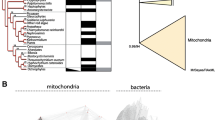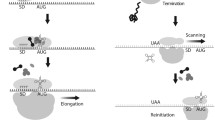Summary
Subunit 8 of mitochondrial ATP synthase (A8), a mitochondrially encoded polypeptide, has no known homologue in any prokaryotic or plastid ATP synthase, suggesting that it has been recruited to its present role in the enzyme from an extraneous source. The polypeptide is poorly conserved at the primary sequence level, but shows a well-conserved hydropathy profile. The hydropathy profiles of A8 from diverse taxa were compared with those of thehok family of prokaryotic respiratory toxins, some of whose members are involved in plasmid maintenance, through postsegregational killing of cells that lose the plasmid at cell division. Such comparisons revealed a highly significant degree of similarity, suggesting a functional relationship. Based on these findings, it is proposed that A8 evolved from ahok-like protein, whose original role was the maintenance of an extrachromosomal replicon in the endosymbiont ancestor of mitochondria. An aggressive mechanism for the evolutionary maintenance of mitochondrial DNA overcomes many of the failings of traditional explanations for its retention as a separate genome.
Similar content being viewed by others
References
Bachmayer H, Benson AM, Yasunobu KT, Garrard WT, Whiteley HR (1968) Nonheme iron proteins. IV. Structural studies ofMicrococcus aerogenes rubredoxin. Biochemistry 7:986–996
Baker A, Schatz G (1987) Sequences from a prokaryotic genome or the mouse dihydrofolate reductase gene can restore the import of a truncated precursor protein into yeast mitochondria. Proc Natl Acad Sci USA 84:3117–3121
Banroques J, Delahodde A, Jacq C (1986) A mitochondrial RNA maturase gene transferred to the yeast nucleus can control mitochondrial mRNA splicing. Cell 46:837–844
Chomyn A, Mariottini P, Cleeter MNJ, Ragan CI, Doolittle RF, Matsuno-Yagi A, Hatefi Y, Attardi G (1985) Functional assignment of the products of the unidentified reading frames of human mitochondrial DNA. In: Quagliariello E, Slater EC, Palmieri F, Saccone C, Kroon AM (eds) Achievements and perspectives of mitochondrial research, vol II. Elsevier, Amsterdam, pp 259–275
Clary DO, Wolstenholme DR (1985) The mitochondrial DNA molecule ofDrosophila yakuba: nucleotide sequence, gene organization and genetic code. J Mol Evol 22:252–272
Clayton DA (1982) Replication of animal mitochondrial DNA. Cell 28:693–705
Devereux J, Haeberli P, Smithies O (1984) A comprehensive set of sequence analysis programs for the VAX. Nucleic Acids Res 12:387–395
Farrell LB, Nagley P (1987) Human liver cDNA clones encoding proteolipid subunit 9 of the mitochondrial ATPase complex. Biochem Biophys Res Commun 144:1257–1264
Fearnley IM, Walker JE (1986) Two overlapping genes in bovine mitochondrial DNA encode membrane components of ATP synthase. EMBO J 5:2003–2008
Flamm JA, Friessen JD, Otsuka AJ (1988) The nucleotide sequence of theEscherichia coli rts gene. Gene 74:555–558
Fox TD (1983) Mitochondrial genes in the nucleus. Nature 301: 371–372
Fukuda M, Wakasugi S, Tsuzuki T, Nomiyama H, Shimada T, Miyata T (1985) Mitochondrial DNA-like sequences in the human nuclear genome. Characterization and implications in the evolution of mitochondrial DNA. J Mol Biol 186:257–266
Gerdes K, Bech FW, Jørgensen ST, Løbner-Olesen A, Rasmussen PB, Atlung T, Boe L, Karlstrom O, Molin S, von Meyerburg K (1986) Mechanism of postsegregational killing by thehok gene product of theparB system of plasmid R1 and its homology with therelF gene product of theE. coli relB operon. EMBO J 5:2023–2029
Gerdes K, Helin K, Christensen OW, Løbner-Olesen A (1988) Translational control and differential RNA decay are key elements regulating postsegregational expression of the killer protein encoded by theparB locus of plasmid R1. J Mol Biol 203:119–129
Jacobs HT, Posakony JW, Grula JW, Roberts JW, Xin J-H, Britten RJ, Davidson EH (1983) Mitochondrial DNA sequences in the nuclear genome ofStrongylocentrotus purpuratus. J Mol Biol 165:609–632
Jacobs HT, Elliott DJ, Math VB, Farquharson A (1988) Nucleotide sequence and gene organization of sea urchin mitochondrial DNA. J Mol Biol 202:185–217
Kornberg A (1980) DNA replication. W.H. Freeman, San Francisco
Kyte J, Doolittle RF (1982) A simple method for displaying the hydropathic character of a protein. J Mol Biol 157:105–132
Masters BS, Stohl LL, Clayton DA (1987) Yeast mitochondrial RNA polymerase is homologous to those encoded by bacteriophage T3 and T7. Cell 51:89–99
Macreadie IG, Novitski CE, Maxwell RJ, John U, Ooi BG, McMullen GL, Lukins HB, Linnane AW, Nagley P (1983) Biogenesis of mitochondria: the mitochondrial gene (aap1) coding for mitochondrial ATPase subunit 8 inSaccharomyces cerevisiae. Nucleic Acids Res 11:4435–4451
Nagley P (1988) Eukaryotic membrane genetics: the F0 sector of mitochondrial ATP synthase. Trends Genet 4:46–52
Nagley P, Farrell LB, Gearing DP, Nero D, Meltzer S, Devenish RJ (1988) Assembly of functional proton-translocating ATPase complex in yeast mitochondria with cytoplasmically synthesized subunit 8, a polypeptide normally encoded within the organelle. Proc Natl Acad Sci USA 85:2091–2095
Netzker R, Kochel HG, Basak N, Kuentzel H (1982) Nucleotide sequence ofAspergillus nidulans mitochondrial genes coding for ATPase subunit 6, cytochrome oxidase subunit 3, seven unidentified proteins, four tRNAs and L-rRNA. Nucleic Acids Res 10:4783–4794
Nordström K, Austin SJ (1989) Mechanisms that contribute to the stable segregation of plasmids. Annu Rev Genet 23: 37–69
Polisky B (1988) colE1 replication control circuitry: sense from antisense. Cell 55:929–932
Power SD, Lochrie MA, Poyton RO (1986) The nuclear coded subunits of yeast cytochromec oxidase. The amino acid sequences of subunits VII and VIIa, structural similarities between the three smallest polypeptides of the holoenzyme, and implications for biogenesis. J Biol Chem 261:9206–9209
Roe BA, Ma D-P, Wilson RK, Wong JFH (1985) The complete nucleotide sequence of theXenopus laevis mitochondrial genome. J Biol Chem 260:9759–9774
Sakaguchi N, Kashiwamura S, Kimoto M, Thalmann P, Melchers F (1988) B lymphocyte lineage-restricted expression ofmbl, a gene with CD3-like structural properties. EMBO J 7: 3457–3464
Schagger H, Borchart U, Aquila H, Link TA, von Jagow G (1985) Isolation and amino acid sequence of the smallest subunit of beef heartbc 1 complex. FEBS Lett 190:89–94
Schinkel AH, Tabak HF (1989) Mitochondrial RNA polymerase: dual role in transcription and replication. Trends Genet 5:149–154
Tanaka M, Haniu M, Yasunobu KT, Norton TR (1975) Amino acid sequence of theAnthopleura xanthogrammica heart stimulant, Anthopleurin A. Biochemistry 16:204–208
Thorsness PE, Fox TD (1990) Escape of DNA from mitochondria to the nucleus inSaccharomyces cerevisiae. Nature 346:376–379
Wechsler T, Suter F, Fuller RC, Zuber H (1985) The complete amino acid sequence of the bacteriochlorophyllc binding polypeptide from chlorosomes of the green photosynthetic bacteriumChloroflexus aurantiacus. FEBS Lett 181:173–178
Wu WY, Du YC (1984) Amino acid sequence of cytotoxin 5 from the Chinese cobraNaja naja atra. Acta Biochim Biophys Sin 16:310–315
Author information
Authors and Affiliations
Rights and permissions
About this article
Cite this article
Jacobs, H.T. Structural similarities between a mitochondrially encoded polypeptide and a family of prokaryotic respiratory toxins involved in plasmid maintenance suggest a novel mechanism for the evolutionary maintenance of mitochondrial DNA. J Mol Evol 32, 333–339 (1991). https://doi.org/10.1007/BF02102192
Received:
Issue Date:
DOI: https://doi.org/10.1007/BF02102192




